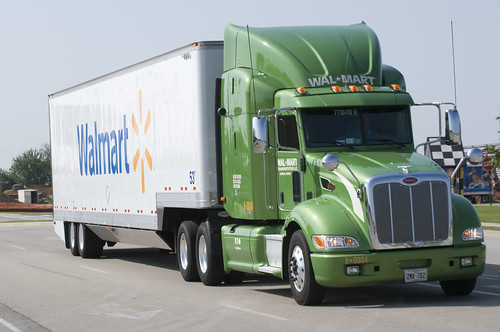Next time you’re at the grocery store buying produce grown ten states away, don’t be too shocked at the price. You know transportation costs are factored in, and you know what gas prices are like right now. But did you know the semi trucks used to haul food from where it’s grown to where it’s sold only average about six miles per gallon? Large trucks are responsible for roughly 20 percent of the petroleum consumption in the United States. No wonder strawberries, cherries, and avocados are so expensive.
The trucking industry, and the design of the trucks themselves, have remained largely unchanged for the past five decades. As car manufacturers come out with more and more eco-friendly hybrid models, and drivers downsize from Hummers to hatchbacks, tractor-trailer trucks continue to guzzle gas as they crisscross the country, there by inflating prices of produce and other items we buy every day. It’s time for a change. Here are just a few ways the trucking industry can go green.
Reduce Speed
Sounds simple, doesn’t it? It is. The faster any vehicle goes, the more fuel it uses. Add several tons of cargo in the trailer, and even more fuel is consumed. Part of what causes truck drivers to speed is the sometimes unrealistic schedules they’re given to make deliveries. They must drive faster to meet deadlines. In addition, some trucking companies pay their drivers by the mile. More miles covered means higher paychecks, so there’s incentive to speed.
Sadly, aside from using more fuel, this also increases the risk of trucking accidents. The first change the trucking industry can make toward being green is to move away from the pay-per-mile model, and take away the incentive for drivers to speed. Less gas will be used, and the probability of truck crashes will decrease.
Use Alternative Fuels
Now that so many hybrid car models are being manufactured, the next logical step seems obvious—adjust that technology to make it applicable to and usable in semi trucks. It may be a more difficult proposition taking into account the size of the trucks, and full trailers, which can weigh up to 80,000 pounds. But it will be one of the most effective ways to green the trucking industry, thereby saving money from the trucking companies all the way down to the individual consumers.

In addition to ethanol fuels, or possibly electric options for trucks, another possible fuel source is solar energy. The tops of trailers offer about 300 square feet of surface area where solar panels could be installed. Imagine a truck being recharged as it was driven. Not only would this save on gas, it would mean fewer stops for the driver (aside from rest stops and breaks) because of not having to refuel, which would mean cargo arriving at its destination more quickly. In addition, solar-powered trucks would mean a reduction in pollution and greenhouse gas emissions.
Build Aerodynamic Trucks
You’ve seen those huge semi trucks barreling down the highway. Haven’t you ever wondered about the aerodynamics of those big, square cabs, not to mention the giant rectangular trailers? Luigi Colani had the same questions, and he decided to do something about them. Colani first began tinkering with the idea of an aerodynamic, fuel-efficient semi truck in the early 1970s during the OPEC oil embargo that caused gas prices to soar out of control. Once that crisis died down, though, no one was really interested in hearing his ideas.
Fast forward to 2008, when the United States was on the brink of an economic crisis, and gas prices were once again skyrocketing. Colani had been perfecting his design over the course of about 40 years, and his idea is getting closer to fruition. His trucks look like futuristic vehicles from a science fiction movie, but test showed they reduced fuel consumption by 30 to 50 percent. The biggest obstacle right now is cost. The trucks cost $1 million to build. Until a truck manufacturer agrees to mass-produce them, they’ll remain out of reach for trucking companies.
These are just a few of the ways trucking companies can go the eco-friendly route, not only saving themselves money, but passing those savings along to the consumer. For now, you’ll have to keep paying premium prices for your strawberries.

Noble McIntyre is the senior partner and owner of McIntyre Law (website: http://www.oklahoma-law.com/) and an experienced Oklahoma truck accident attorney.
Photo credits: Walmart Stores and Living Off Grid







I think it’s great that the trucking industry is striving to save on fuel costs. It seems that so many of our consumer products are increasing in price. Most claim it’s solely due to the devaluing of the dollar, but there are other factors involved such as shipping costs. Another thing the industry is doing to cut down on fuel costs is using technology to plan and track truck routes to conserve miles and fuel. GPS tracking systems have helped also to improve route efficiencies.